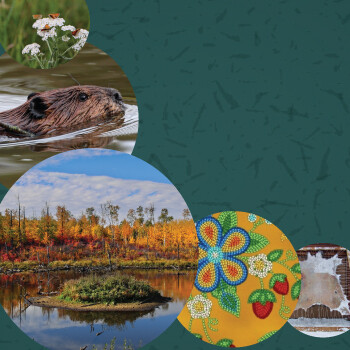How Ceremony Connects Us All: Learning from Indigenous Knowledges

Supporting Indigenous people and communities to establish (or re-establish) their relationships with the land in the Beaver Hills is central to the Beaver Hills Biosphere’s (BHB) work. The BHB’s Indigenous Engagement Coordinator Bob Montgomery (Métis Nation of Alberta) and Indigenous Program Coordinator Emory Arcand (Alexander First Nation) work directly to facilitate these connections, and the importance of connecting Indigenous peoples to the land is a guiding principle in all our work.
In March of this year, as part of an initiative led by the Canadian Biosphere Region Association (CBRA), the BHB gathered with other biospheres and Indigenous partners over two days in the Beaver Hills to explore common threads in working with Indigenous partners. We connected with Nation members from Mâskwâcis and Enoch as well as other community members. Blackfoot, Cree, Métis and Saulteaux Nation representatives who have partnered with one of the four prairie biospheres were also in attendance. These folks are very skilled in what Western scientists call ‘conservation.’ From an Indigenous perspective, these knowledges can be described as kwayaski-wâtisiwin in Cree or ‘the correct way of living.’ Other Nations have similar concepts that would be more holistic than conservation from a Western worldview.
At this meeting, Indigenous Elders, knowledge holders and educators also encouraged us to include ceremony in our work. For many Indigenous people and communities, ceremonies are important because they represent a shared responsibility. For context, consider the Western concept of a Memorandum of Understanding (MOU); an agreement between two parties to coordinate efforts and work together towards a common goal.
Like a MOU, ceremony is an agreement to work together but it is NOT an MOU – it is more salient. Indigenous peoples must lead these conversations and ceremonies, and they must be conducted by an Elder or Knowledge Holder recognized by their community.
“For me, ceremony is more of a lived and ongoing experience meant to rekindle connection, relations and understanding amongst each other – wahkohtowin (kinship),” explains Beaver Hills Biosphere’s Outreach Coordinator, Pamela Billey, who is of Métis descent. Pamela goes on to say:
“Ceremony is the foundation of building relations and is perhaps where each conversation can begin, where we can accept others, listen, learn and share through a new process together.”
Encouraged by the teachings of the Elders and others at the CBRA gathering, and seeking an opportunity to nourish relationships between the Biosphere and Indigenous community partners, Bob and Emory began planning for a pipe ceremony to take place in the Beaver Hills. We are responsible to the Land because the Land provides us with everything we know, and a pipe ceremony is an example of practicing ethical relationality[1] with the land as a living being.
The pipe ceremony was held on May 19 at Miquelon Lake Provincial Park beside the University of Alberta’s Hesje Observatory and Research Centre. The Research Centre is a vital site for research and projects affecting the Biosphere, including studying the animals of the area, and testing soil and water chemistry. What is absent from this work are Indigenous specific sciences and worldviews that are governed by natural and spiritual laws. So, it was fitting that the pipe ceremony take place here.
For the ceremony, more than 40 people from Nations across Treaty 6 as well as staff and board members from the Biosphere gathered in a circle under the sun. We sat together and focused our attention on the absence of Indigenous peoples, and therefore Indigenous knowledges in the Beaver Hills since the late 1800s when colonization forced them from their lands here.
We recognized how critically important it is now to have Indigenous peoples here, in the Beaver Hills, practicing Indigenous knowledges as a way of healing the land and ourselves. Elders prayed and encouraged others to connect with their own conception of God, Creator, universe or nature. We greeted each other, some in English, others in Nêhiyâwêwin (Cree) or Anishinaabemowin (Ojibway). We spoke about what was missing, who was missing and considered how we might change going forward, to remedy those omissions. Afterwards, we all shared a feast and visited with one another, laughed and told stories.
Bob Montogomery, who also attended the ceremony, had this to add,
“It was a beautiful day – ê-kî-miyo-kisikaw, one that will provide much needed learning and guidance for how to proceed.”
There is still much work to be done but the power of coming together in ceremony with collective minds, hearts and spirits cannot be underestimated.
ekosi pitima – that is all for now.
[1] Donald, D. (2016). Chapter Three: From What Does Ethical Relationality Flow? An “Indian” Act in Three Artifacts. Counterpoints, 478, 10–16. http://www.jstor.org/stable/45157205